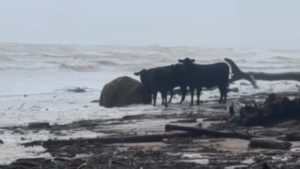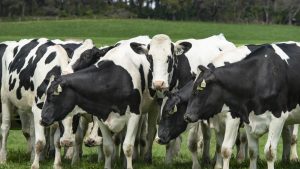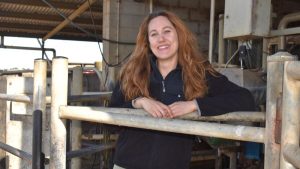
Key points:
The Smart family are putting their dairy cows and Mypolonga farm on the market after the entire property was flooded
With the help of the community, the family walked more than 500 of their dairy cows 3.5 kilometres to higher ground
More than 3,400 properties in SA have been inundated so far by the River Murray flood
For one Murraylands family, this means being forced to sell their dairy cows and farm after a levee breach caused their entire property to flood.
The Smart family spent almost 40 years building their dairy empire and within days, it became nonexistent.
The Mypolonga farm is run by David Smart, his three sons and son- in-law, all of whom are now looking for new jobs and a new way of life.
Floodwaters have just peaked at nearby Mannum, with SES satellite data showing more than 3,400 properties have been inundated by the River Murray flood.
David Smart’s daughter Katrina Moore said although the family worked tirelessly to protect their farm, the situation turned more quickly than expected.
“We thought we had a few days, then suddenly one night we got a phone call saying the levee bank has breached, and the water is coming in fast,” she said.
“So from then on it was pretty much all hands on deck to get the cows to higher ground.”
Farm entirely submerged
As the levee break grew bigger, the family was left to play what Mrs Moore described as “a waiting game”, to see how much higher the water would get.
As a precaution, the family began clearing out the dairy farm’s milking robots and office.
But soon, the entire property would be completely submerged.
“The whole lot. The paddocks, the milking shed … everything is under,” Mrs Moore said.

After the farm was inundated, the Smart family made the heartbreaking decision to sell their dairy farm.
“No one really wanted to sell the farm,” Mrs Moore said.
“It’s what we have to do to live, because we can’t keep going the way we are.
“Dad always said he was building up the farm for the future of us kids.
“And once the [milking] robots came, we thought we would be set for our kids in the future … now for that to just all be gone — it’s hard.”
Finding work elsewhere
The future is uncertain for the Smart family, as they come to terms with not only the loss of their dairy farm, but their livelihoods too.
“My husband is going to have to find work somewhere else, as are all my brothers,” Mrs Moore said.
“No one’s really sure about what they want to do, or where they want to go.
‘We’ve really always been on the farm together … and now it’s just all gone and we’re all going to have to go our separate ways.”

While they wait for the water to recede, which could take years, the family will slowly begin to sell their dairy cows, milking robots and any machinery from their dairy business.
“We can’t sell the paddocks [yet], but we can sell everything else,” Mrs Moore said.
“It’s devastating that this is the case now.
“Most people out there probably think it’s just some swaps — they’ll get over it, but it’s more than that to us.”
Walking 500 head of cattle to safety
Katrina’s father David Smart has been a Mypologna local for 43 years.
The loss of his family’s dairy farm was devastating, he said.
Mr Smart said once the levee broke, the family relied on the support of the community to walk more than 500 of his dairy cows 3.5 kilometres, to the safety of a higher paddock on another farm.
“Every time we made a plan another road got closed because of water, so we had to keep changing it,” he said.

“We’re on a neighbouring farm a little bit further up the road and milking is taking forever and is really hard work.
“That was one of the driving points in the decision that we made [to sell the farm].”
Where the cows would once walk themselves into the dairy shed to be milked robotically, the Smart family are struggling to milk the animals using a rotary system and infection is a problem.
Mr Smart said the current focus was on getting the cows milked and into a healthy, saleable condition.
“I’d hate for them to go to meatworks after 40 years of breeding, but it might be the only option,” he said.
Relief funding ‘a nothing figure’
In a joint-funding arrangement, the federal and state governments have offered those in flood-affected areas of South Australia an additional $126 million in relief funding, with primary producers able to claim recovery grants up to $75,000.
But Mr Smart said that money would not help.

“It’s a nothing figure really, the costs involved in day-to-day running have quadrupled for us, and $75,000 won’t last us a week,” he said.
“It’s not going to get my farm back.
“One of the key factors in the decision [to sell the farm] was trying to keep the family together. If we kept going the way we were going it probably would’ve broken the family.
“It’s just not sustainable for me to keep going.”
‘Everyone just came out and helped’
Throughout the ordeal, Mr Smart said the local community banded together to offer their support.
“The day we wanted to move the cows, everyone just came out and helped,” he said.
“I’ve got relief milkers coming in tomorrow morning to give two of us a morning off … it’s just small things, but they’re huge.
“One of the hardest things is, when we built our house, we built it with a view; every time I walk out the door I see water, and it’s just heartbreaking.”
Recovery grants for flood-affected primary producers can be accesses by calling 1800 931 314 or visiting the South Australian Department of Primary Industries and Regions’ website.
























